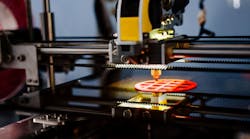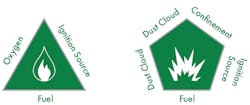Additive Manufacturing and Combustible Dust Hazards in 3D Printing
Over the last few years we have witnessed the expansion of additive manufacturing using 3D printers from utilization as a prototyping tool to increasing implementation on the plant floor. The rapid evolution of this technology and its applications has created new challenges for process safety. These challenges involve understanding powder combustibility properties and how best to implement reliable inverting measures to prevent fires and explosions during powder processing and handling.
An EHS professional or employee in charge of reviewing and approving use of a 3D printer in their facility should be aware of the hazards associated when it comes to combustible dust.
Risks in the process of additive manufacturing
Materials used in additive manufacturing cover a very wide range, from plastics such as nylon, ABS, high density polyethylene, polyethylene terephthalate and others, to metals such as stainless steel, titanium, aluminum and their alloys or even gold or silver. Most of these materials are combustible and, therefore, explosive as dusts. The 3D printing process itself generates dust; in fact, it can produce very small particles (even in the nanoparticle range). Some metals such as titanium and aluminum can burn very fast and produce extremely high temperatures and pressures, necessitating extra caution. Some metals, like titanium, require a special mention for their high explosion index.
The degree of hazard linked to dust is heavily dependent on the amount of material in question, and its behavior in that quantity. A dust explosion is caused by the rapid combustion of particles suspended in air in an enclosed space. When these particles come into contact with a spark, an open fire, an overheated surface or electrical discharge from machinery, an explosion can occur.
Figure 1. Fire triangle and explosion pentagon. Users of additive manufacturing are often working with fuel and oxygen, so ignition sources need to be avoided to prevent fires or explosions.
The image above, used by OSHA and other agencies to communicate the risks of powder handling, illustrates how fire and explosion result from a combination of conditions. As shown, when handling combustible dust or powder in ambient atmospheres, all that is needed is a suitable ignition source to initiate a fire. If this occurs in the presence of a dust cloud with many particles dispersed in a contained area, it could lead to a larger, more damaging explosion in a matter of milliseconds. Preventing metal dust clouds from forming is therefore of paramount importance.
What to do about these risks?
Management of the hazards posed by combustible dusts has been regulated in the last decades. For instance, the so-called ATEX Directives and ISO standards (mainly ISO 60079) apply in the European Union and some other countries. In the United States, National Fire Protection Association standards (mainly NFPA 652, 654 and specifically for metallic dusts, NFPA 484) aim to reduce combustible dust hazards.
These standards and regulations require measures be taken to capture and contain fugitive dust generated during machining activities. The standards outline prescriptive requirements for these dust collection systems that govern the design and construction of the containment equipment, or call for explosion venting or explosion suppression systems. In lieu of prescriptive requirements, performance-based approaches can also be considered in order to manage these hazards. These approaches typically may be scrutinized by Authorities Having Jurisdiction (AHJ’s)
While there are standards for metal dusts in general, specific questions may arise when it comes to additive manufacturing, such as requiring the electrical equipment inside the printers to be classified for use in hazardous areas, explosion or deflagration venting, and limitations on the handling and storage of materials, all of which can significantly influence the cost of installing a 3D metal printer.
We suggest you formulate your combustible dust fire and explosion management program to include the following steps before you implement a 3D printing process on your premises:
Developing a dust sampling and testing program - to identify and test materials present in the process to determine the explosibility and ignitability characteristics necessary to complete the analysis
Dust Hazard Analysis (DHA) – to identify potential unsafe operating conditions and potential risks in the design and to provide recommendations for appropriate process safety measures, including engineering controls, equipment and procedures
Development of written safety procedures - to detail the procedures and operational guidelines necessary for the safe operation of the facility
Fundamentals of combustible dust training program – to train your personnel on-site
Effective risk management requires an understanding of the specific hazards associated with these powders/dusts and of the risks that may be present at your particular facility based on its likelihood and severity parameters. Common testing that can be used when preparing for 3D printing process include combustible dust explosibility and ignitibility properties, electrostatics and thermal stability. Ensure that anyone you choose to work with can assist you in developing strategies to ensure safety, including housekeeping, dust control and separation and segregation.

